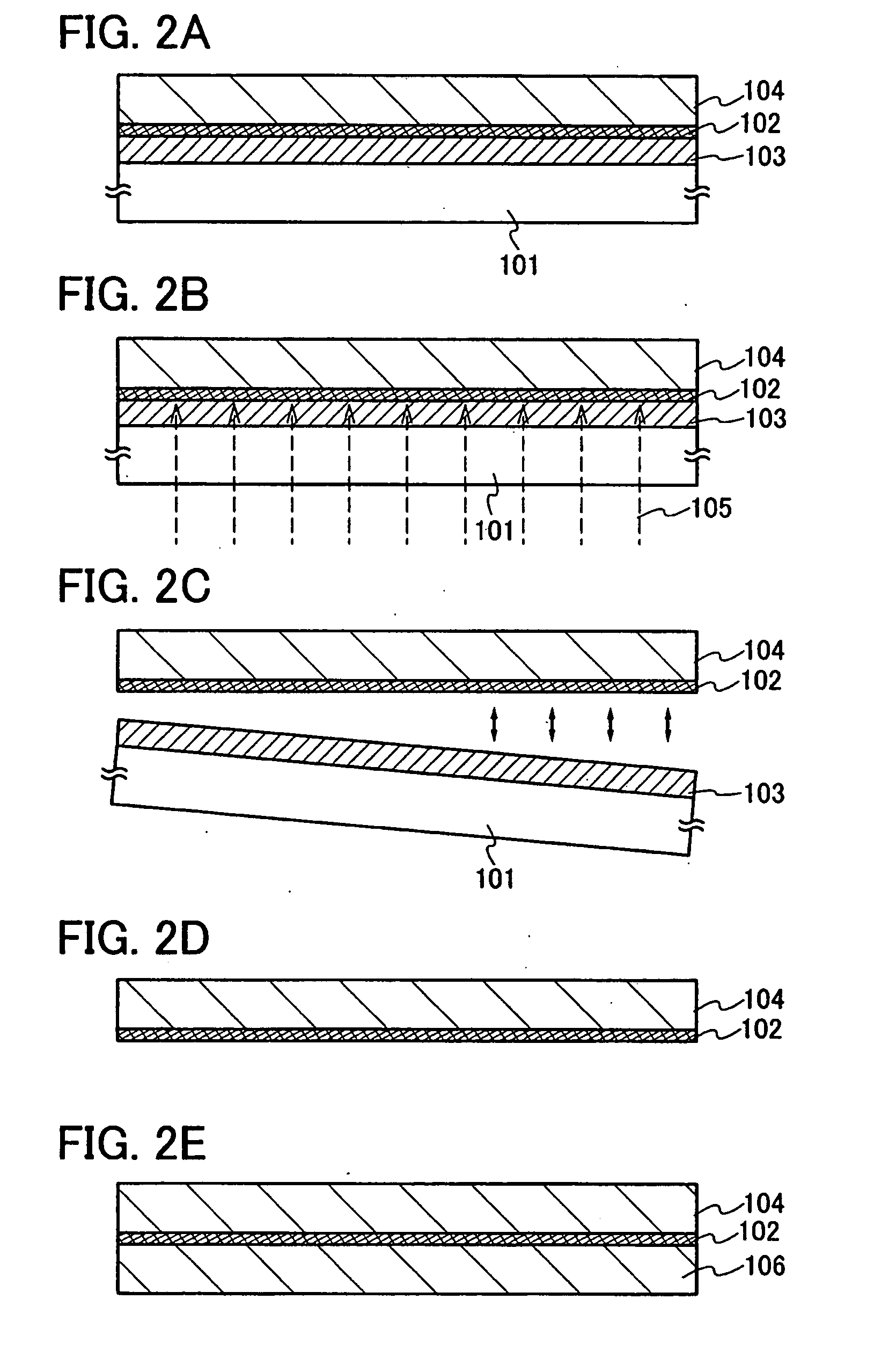Method for manufacturing semiconductor device
a manufacturing method and semiconductor technology, applied in the direction of sustainable manufacturing/processing, final product manufacturing, instruments, etc., can solve the problems of low yield, difficult to manufacture thin film transistors, memory and solar cells having fine structures, and difficult to achieve the reduction in size and weight, and achieve the improvement of performance of semiconductor devices. , the effect of high yield and easy manufacturing
- Summary
- Abstract
- Description
- Claims
- Application Information
AI Technical Summary
Benefits of technology
Problems solved by technology
Method used
Image
Examples
embodiment mode 1
[0059]This embodiment mode will describe a method for manufacturing a semiconductor device having flexibility with high yield by separating an element forming layer from a substrate having a light transmitting property, with reference to FIGS. 1A to 1E.
[0060]As shown in FIG. 1A, a photocatalytic layer 102 is formed over a substrate 101 having a light transmitting property, and an organic compound layer 103 is formed over the photocatalytic layer 102. Next, an element forming layer 104 is formed over the organic compound layer 103.
[0061]As the substrate 101 having the light transmitting property, a glass substrate, a quartz substrate, a plastic substrate having heat resistance enough to withstand the process temperature of the process, or the like can be used. Since the above-mentioned substrate 101 having a light transmitting property is not restricted in size and shape, for example, a rectangular substrate with a length of 1 m or more on a side can be used as the substrate 101 havi...
embodiment mode 2
[0074]This embodiment mode will describe another mode of a manufacturing process of the photocatalytic layer 102 and the organic compound layer 103, which is different from Embodiment Mode 1, with reference to FIGS. 2A to 2E.
[0075]As shown in FIG. 2A, the organic compound layer 103 is formed over the substrate 101 having the light transmitting property, and the photocatalytic layer 102 is formed over the organic compound layer 103. Then, the element forming layer 104 is formed over the photocatalytic layer 102.
[0076]In this embodiment mode, since the photocatalytic layer 102 is irradiated with light through substrate 101 having a light transmitting property and the organic compound layer 103, the organic compound layer 103 is formed using a material capable of transmitting light which is to be delivered later. Typically, a material capable of transmitting any of ultraviolet rays, visible rays, or infrared rays is used. As an organic compound having a light transmitting property, the...
embodiment mode 3
[0080]This embodiment mode will describe a mode in which a semiconductor device is formed using an organic compound layer 112 in which inorganic compound particles are dispersed instead of the organic compound layer 103 in Embodiment Modes 1 and 2, with reference to FIGS. 3A to 3E. Note that in this embodiment mode, Embodiment Mode 1 is used for description; however, Embodiment Mode 2 can be applied.
[0081]As shown in FIG. 3A, the photocatalytic layer 102 is formed over the substrate 101 having the light transmitting property, and the organic compound layer 112 is formed over the photocatalytic layer 102. Then, the element forming layer 104 is formed over the organic compound layer 112. Note that as the organic compound layer 112, inorganic compound particles 111 are dispersed in an organic compound 110.
[0082]As the inorganic compound particles 111, silicon oxide, silicone nitride, aluminum oxide, tantalum oxide, barium fluoride magnesium, or the like can be used. When the inorganic ...
PUM
| Property | Measurement | Unit |
|---|---|---|
| Flexibility | aaaaa | aaaaa |
| Wavelength | aaaaa | aaaaa |
| Light | aaaaa | aaaaa |
Abstract
Description
Claims
Application Information
 Login to View More
Login to View More - R&D
- Intellectual Property
- Life Sciences
- Materials
- Tech Scout
- Unparalleled Data Quality
- Higher Quality Content
- 60% Fewer Hallucinations
Browse by: Latest US Patents, China's latest patents, Technical Efficacy Thesaurus, Application Domain, Technology Topic, Popular Technical Reports.
© 2025 PatSnap. All rights reserved.Legal|Privacy policy|Modern Slavery Act Transparency Statement|Sitemap|About US| Contact US: help@patsnap.com



